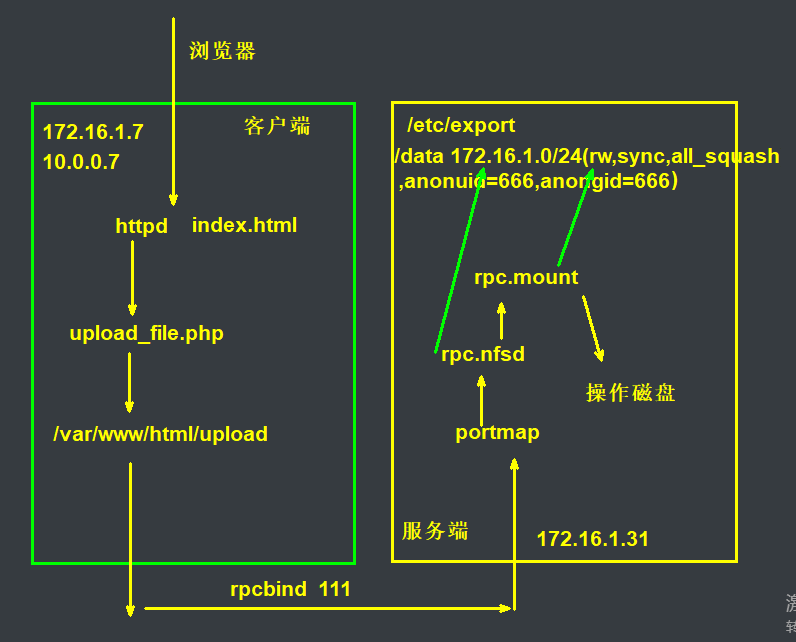一、统一用户
1.httpd
2.NFS挂载目录
3.rsync
1.所有服务器统一创建用户
[root@web01 ~]# groupadd www -g 666
[root@web01 ~]# useradd www -u 666 -g 666
2.修改httpd用户
[root@web01 ~]# vim /etc/httpd/conf/httpd.conf
User www
Group www
#重启服务
[root@web01 ~]# systemctl restart httpd
[root@web01 ~]# ps -ef | grep httpd
root 31537 1 1 21:57 ? 00:00:00 /usr/sbin/httpd -DFOREGROUND
www 31538 31537 0 21:57 ? 00:00:00 /usr/sbin/httpd -DFOREGROUND
www 31539 31537 0 21:57 ? 00:00:00 /usr/sbin/httpd -DFOREGROUND
www 31540 31537 0 21:57 ? 00:00:00 /usr/sbin/httpd -DFOREGROUND
www 31541 31537 0 21:57 ? 00:00:00 /usr/sbin/httpd -DFOREGROUND
www 31542 31537 0 21:57 ? 00:00:00 /usr/sbin/httpd -DFOREGROUND
root 31544 18601 0 21:57 pts/1 00:00:00 grep --color=auto httpd
3.修改NFS服务端权限
[root@NFS /data]# vim /etc/exports
/data 172.16.1.0/24(rw,sync,all_squash,anonuid=666,anongid=666)
#重启
[root@NFS /data]# systemctl restart NFS

4.修改rsync用户
[root@backup ~]#vim /etc/rsyncd.conf
uid = www
gid = www
port = 873
fake super = yes
use chroot = no
max connections = 200
timeout = 600
ignore errors
read only = false
list = false
auth users = rsync_backup
secrets file = /etc/rsync.passwd
log file = /var/log/rsyncd.log
#####################################
[backup]
comment = welcome to oldboyedu backup!
path = /backup
5.NFS服务端重新授权目录
[root@NFS ~]# chown -R www.www /data/
6.web端重新挂载
[root@web01 /var/www/html]# umount /var/www/html/upload
[root@web01 /var/www/html]# mount -t NFS 172.16.1.31:/data ./upload
7.rsync服务端重新授权目录
[root@backup ~]#chown -R www:www /backup
二、NFS总结
1.NFS储存优点
1)简单易用,部署方便
2)数据可查,服务稳定
2.NFS的服务缺点
1)存在单点故障, 如果构建高可用维护麻烦web->NFS()->backup
2)NFS数据明文, 并不对数据做任何校验。
3)客户端挂载NFS服务没有密码验证, 安全性一般(内网使用)
3.NFS应用建议
1)开机挂载
如果希望NFS文件共享服务能一直有效,则需要将其写入到fstab文件中
#编辑fstab文件
[root@NFS-client ~]# vim /etc/fstab
172.16.1.31:/data /NFSdir NFS defaults 0 0
#验证fstab是否写正确
[root@NFS-client ~]# mount -a
2)生产场景应将静态数据尽可能往前端推,减少后端存储压力
3)必须将存储里的静态资源通过CDN缓存,jpgpngmp4avicssjs
4)如果没有缓存或架构本身历史遗留问题太大, 在多存储也无用

三、rsync+NFS解决单点故障
1.环境准备
|
主机 | 角色 | IP |
|---|---|---|
| backup | rsync服务端,NFS服务端 | 172.16.1.41 |
| NFS | rsync客户端,NFS服务端 | 172.16.1.31 |
| web01 | rsync客户端,NFS客户端 | 172.16.1.7,10.0.0.7 |
2.web01搭载上传作业平台
1.安装httpd和php
[root@web01 ~]# yum install -y httpd php
2.上传代码
[root@web01 ~]# rz kaoshi.zip
[root@web01 ~]# yum unzip
[root@web01 ~]# unzip kaoshi.zip -d /var/www/html/
3.创建httpd用户
[root@web01 ~]# groupadd www -g 666
[root@web01 ~]# useradd www -u 666 -g 666
4.配置httpd服务
[root@web01 ~]# vim /etc/httpd/conf/httpd.conf
User www
Group www
#开启服务
[root@web01 ~]# systemctl start httpd
5.修改权限
[root@web01 ~]# chown -R www.www /var/www/html/
3.NFS服务器搭建NFS服务端
1.安装NFS
[root@NFS ~]# yum install -y NFS-utils rpcbind
2.配置NFS
[root@backup ~]# vim /etc/exports
/data 172.16.1.0/24(rw,sync,all_squash,anonuid=666,anongid=666)
3.查看配置生效
[root@backup ~]# cat /var/lib/nfs/etab
/data 172.16.1.0/24(rw,sync,wdelay,hide,nocrossmnt,secure,root_squash,all_squash,no_subtree_check,secure_locks,acl,no_pnfs,anonuid=666,anongid=666,sec=sys,rw,secure,root_squash,all_squash)
4.创建用户
[root@web01 ~]# groupadd www -g 666
[root@web01 ~]# useradd www -u 666 -g 666
5.创建目录
[root@web01 ~]# mkdir /data
[root@web01 ~]# chown -R www.www /data
4.挂载web01数据目录
[root@web01 ~]# showmount -e 172.16.1.31
[root@web01 ~]# mount -t nfs 172.16.1.31:/data /var/www/html/upload
5.backup搭建rsync服务端
1.安装rsync
[root@backup ~]# yum -y install rsyncd
2.配置rsync
[root@backup ~]# cat /etc/rsyncd.conf
uid = www
gid = www
port = 873
fake super = yes
use chroot = no
max connections = 200
timeout = 600
ignore errors
read only = false
list = true
auth users = rsync_backup
secrets file = /etc/rsync.passwd
log file = /var/log/rsyncd.log
#####################################
[backup]
comment = "文件备份目录"
path = /backup
[data]
comment = "数据备份目录"
path = /data
3.重启rsync
[root@backup ~]# systemctl restart rsyncd
6.NFS数据实时备份到backup服务器
1.安装inotify
[root@nfs ~]# yum -y install inotify-tools
2.编写脚本实时备份data目录
[root@nfs /data]# vim /scripts/backup_data.sh
7.测试
1.访问交作业页面,上传图片
2.查看web服务器
[root@web01 ~]# ll /var/www/html/upload
3.查看nfs服务器data目录
[root@nfs ~]# ll /data/
4.查看backup服务器data目录
[root@backup ~]# ll /data
8.backup搭建NFS服务端
1.安装NFS
[root@backup ~]# yum install -y nfs-utils rpcbind
2.配种NFS
[root@backup ~]# vim /etc/exports
/data 172.16.1.0/24(rw,sync,all_squash,anonuid=666,anongid=666)
3.创建用户
[root@backup ~]# groupadd www -g 666
[root@backup ~]# useradd www -u 666 -g 666
4.启动服务
[root@backup ~]# systemctl start nfs
9.测试
1.NFS服务器出现故障
[root@nfs ~]# systemctl stop nfs
2.切换挂载机器
[root@web01 ~]# umount -lf /var/www/html/upload
[root@web01 ~]# mount -t nfs 172.16.1.41:/data /var/www/html/upload
四、实时同步
1.实时同步简单介绍
1.概述
实时同步是一种只要当前目录发生变化则会触发一个事件,事件触发后会将变化的目录同步至远程服务器
2.为什么要实时同步
保证数据的连续性, 减少人力维护成本,解决nfs单点故障
3.实时同步数据选择
sersync+RSYNC(√)、inotify+rsync
Inotify是一个通知接口,用来监控文件系统的各种变化,如果文件存取,删除,移动。可以非常方便地实现文件异动告警,增量备份,并针对目录或文件的变化及时作出响应。rsync+inotify可以实触发式实时同步增量备份
sersync是国人基于rsync+inotify-tools开发的工具,不仅保留了优点同时还强化了实时监控,文件过滤,简化配置等功能,帮助用户提高运行效率,节省时间和网络资源。
2.安装sersync(NFS服务器)
1.安装sersync和inotify
[root@nfs01 ~]# yum install rsync inotify-tools -y
2.下载serdync软件包
[root@nfs01 ~]# wget https://raw.githubusercontent.com/wsgzao/sersync/master/sersync2.5.4_64bit_binary_stable_final.tar.gz
3.解压安装包
[root@nfs ~]# tar xf sersync2.5.4_64bit_binary_stable_final.tar.gz
4.移动并改名
[root@nfs ~]# mv GNU-Linux-x86 /usr/local/sersync
5.修改配置文件
[root@nfs ~]# cat /usr/local/sersync/confxml.xml
<?xml version="1.0" encoding="ISO-8859-1"?>
<head version="2.5">
#主机IP
<host hostip="localhost" port="8008"></host>
#调试模式
<debug start="false"/>
<fileSystem xfs="false"/>
#文件过滤
<filter start="false">
<exclude expression="(.*).svn"></exclude>
<exclude expression="(.*).gz"></exclude>
<exclude expression="^info/*"></exclude>
<exclude expression="^static/*"></exclude>
</filter>
#inotify监控配置
<inotify>
#inotify监控的行为
<delete start="true"/>
<createFolder start="true"/>
<createFile start="true"/>
<closeWrite start="true"/>
<moveFrom start="true"/>
<moveTo start="true"/>
<attrib start="true"/>
<modify start="true"/>
</inotify>
#推送部分
<sersync>
#本地监控的目录
<localpath watch="/data">
#远程IP及模块名字
<remote ip="172.16.1.41" name="data"/>
</localpath>
<rsync>
#rsync同步时的参数
<commonParams params="-artuz"/>
#开启认证
<auth start="true" users="rsync_backup" passwordfile="/etc/rsync.password"/>
#如果rsync服务不是873端口,需要开启
<userDefinedPort start="false" port="874"/><!-- port=874 -->
#超时时间
<timeout start="false" time="100"/><!-- timeout=100 -->
<ssh start="false"/>
</rsync>
#指定错误日志
<failLog path="/tmp/rsync_fail_log.sh" timeToExecute="60"/><!--default every 60mins execute once-->
#定时任务,默认600分钟进行一次全备
<crontab start="false" schedule="600"><!--600mins-->
#定时任务文件过滤
<crontabfilter start="false">
<exclude expression="*.php"></exclude>
<exclude expression="info/*"></exclude>
</crontabfilter>
</crontab>
<plugin start="false" name="command"/>
</sersync>
<plugin name="command">
<param prefix="/bin/sh" suffix="" ignoreError="true"/> <!--prefix /opt/tongbu/mmm.sh suffix-->
<filter start="false">
<include expression="(.*).php"/>
<include expression="(.*).sh"/>
</filter>
</plugin>
<plugin name="socket">
<localpath watch="/opt/tongbu">
<deshost ip="192.168.138.20" port="8009"/>
</localpath>
</plugin>
<plugin name=